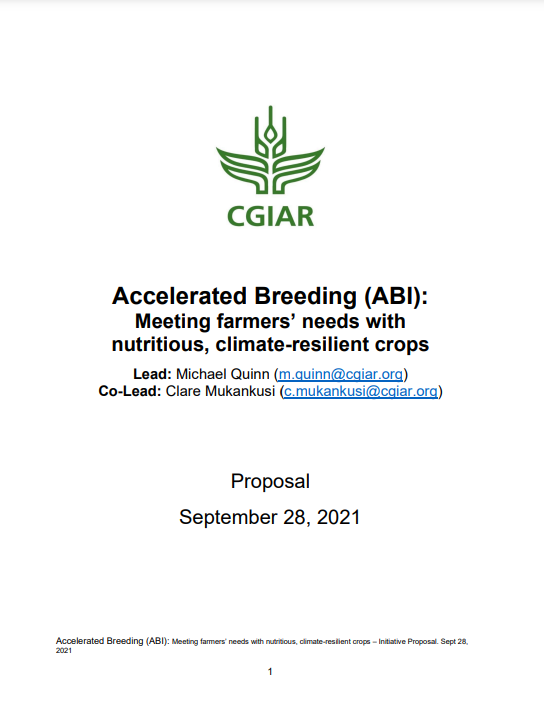Initiative name: Accelerated Breeding Initiative (ABI)
Primary CGIAR Action Area: Genetic Innovation
Proposal Lead and Deputy: Michael G. Quinn and Clare M. Mukankusi
The overarching goal of ABI and of GI is to deliver higher rates of genetic gain in the form of
farmer-preferred varieties and to decrease the average age of varieties in farmers’ fields providing
real-time adaptation to climate change, evolving markets and production systems. The challenge
is that many farmers in target geographies are growing very old (>20-40 years) varieties, and
therefore not benefiting from recent breeding efforts. To trigger timely adoption, new varieties
must offer a step-change in performance that can only be achieved through higher rates of genetic
gain than are currently being achieved. Historically, adoption of improved varieties has occurred
readily due to the obvious value proposition associated with improved plant type, disease
resistance or quality. However, the breeding methods that achieved the previous generations of
improved varieties will not deliver the step-change in performance for the complex traits that are
now needed to achieve the projected benefits for the five Impact Areas.
Including traits related to: increased production under diverse environmental conditions inhabited, and crop management practices used, by smallholders; climate resilience; biofortification; processing characteristics, end-use quality and consumer preferences; and those that address the needs of women, youth and children. This will require a quantitatively optimized and data-driven approach to breeding, faster breeding cycles and greater focus on development of farmer- and consumer- preferred
varieties adapted to distinct production environments, markets and end uses. Furthermore,
moving to more focused breeding approaches that align with impact goals within target
geographies is a prerequisite to aligning CGIAR breeding efforts with funder priorities and for
maximizing benefits to the five CGIAR Impact Areas. This has never been possible in CGIAR due
to the lack of a single, standardized approach to assessing opportunity for impact across crops
and centers. One CGIAR and GI now offer this opportunity, as Market Intelligence and Product
Profiling (MIPP) define the impact case – and the work described by this Initiative enables the
implementation.
Currently, National Agricultural Research and Extension Services (NARES) partners, particularly
in sub-Saharan Africa, have varied levels of capacity with the majority lacking the ability to handle
all processes required to develop improved crop varieties that will be adopted by farmers and a
few having appreciable levels of capacity. As such, there has been a heavy reliance on CGIAR
for variety development by the weaker NARES while at the same time a growing state of
competition between strong NARES and CGIAR. NARES wish to have stronger input into CGIAR
breeding strategies. The challenge is to increase NARES breeding capacity and enable them to
influence CGIAR breeding strategies. Existing CGIAR-NARES networks need to be modified so
they appreciate the comparative advantage of each partner and promote growth. These networks
must also involve the emerging breeding capacities in local small and medium-size seed
enterprises (SME). Higher rates of genetic gain can only be achieved with a change in approach
to testing candidate variety performance that is broader and more representative of farmers’
conditions and end-user preferences. These goals can be facilitated by closer breeding
partnerships between CGIAR, NARES and SME, designed as win-win for all.
Quinn, M. and Mukankusi, C.

